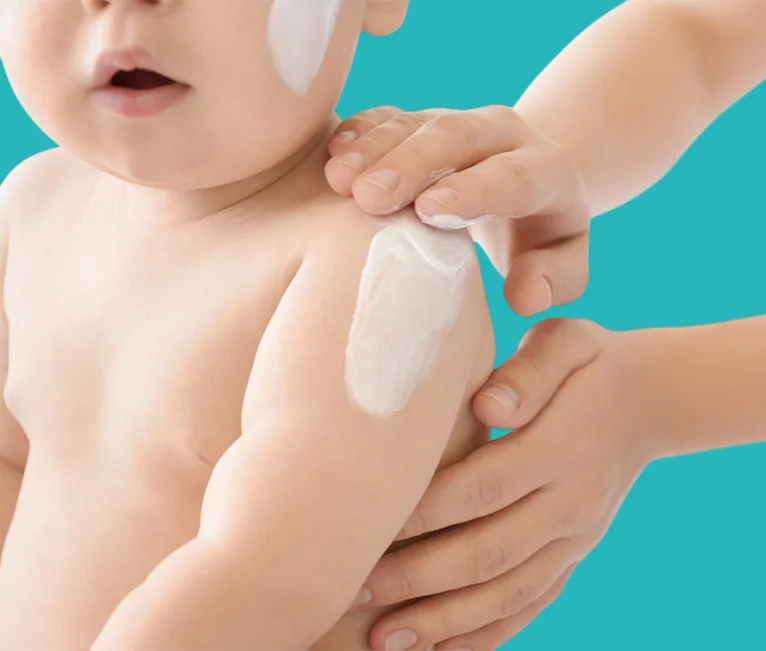Pityriasis alba in children is a non-contagious skin condition that appears as light-colored patches on the face or arms. It is non-itchy or painless.
It is caused by several factors, such as dry skin, sun exposure, or lack of hydration, which can be a concern for parents. However, it can be easily treated with proper skin care.
What is pityriasis alba in children
Pityriasis alba is a mild skin condition that affects children between the ages of 3 and 12 years. It appears as circular or irregular patches.
These patches are slightly dry, covered with light scales, and lighter in color than normal skin. They appear on the face, cheeks, arms, or legs.
Causes of pityriasis alba in children

Pityriasis alba in children is caused by certain factors, including:
- Genetic factors.
- Skin allergies.
- Vitamin D and B12 deficiency.
- Dry skin and lack of hydration.
- Previous skin infections.
- Excessive exposure to sunlight.
- Using perfume, which causes skin irritation.
- Using harsh soap on the skin.
Symptoms of pityriasis alba in children
The symptoms of pityriasis alba in children are clearly visible and do not cause pain or discomfort. They include:
- Mild itching.
- Light white spots.
- Mild scaling on the skin.
- The spots become more visible after sun exposure.
- Skin dryness is evident in the affected area.
How is pityriasis alba diagnosed in children
Diagnosis of pityriasis alba in children depends on a dermatologist's examination and observation of symptoms, such as the location of the white spots.
Sometimes, the doctor may need to examine the skin under a special light or conduct a blood test to ensure there are no vitamin deficiencies or diseases similar to pityriasis alba, such as vitiligo or fungal infections.
Methods for Treating Pityriasis alba in Children
There are several ways to treat pityriasis alba in children, including:
- Using moisturizing creams.
- Applying creams containing mild cortisone.
- Using a gentle cleanser for sensitive skin.
- Avoid any soaps or perfumes that may cause skin irritation.
- Apply appropriate sunscreen to your child when going out during the day.
- Apply creams containing vitamins to help even out skin tone.
Duration of Treatment for Pityriasis Alba in Children
The duration of treatment varies from one child to another depending on the severity of the condition and the child's skin's response to treatment. However, it may take 4 to 8 weeks for the spots to begin to gradually disappear.
In some mild cases, the spots may disappear in a few weeks with regular moisturizing and appropriate treatment. Continuity is essential to prevent recurrence.
How to Protect Your Child from Pityriasis Alba

Protecting children from pityriasis alba depends primarily on skin care, including:
- Using sunscreen during the day.
- Moisturizing your child's skin daily.
- Avoid rubbing or scratching the skin to the point of irritation.
- Choose mild soaps and perfumes.
- Avoid direct sun exposure, especially during peak hours.
- Pay attention to proper nutrition for your child, especially those containing vitamins.
Complications of Pityriasis Alba in Children
Pityriasis Alba in children rarely causes serious complications, but some minor skin problems may occur as a result of neglecting treatment, such as:
- The spots turn a lighter color.
- Skin inflammation and irritation.
- Skin cracking in the affected areas.
- A negative impact on the child's psychological well-being.
Frequently Asked Questions About Pityriasis Alba in Children
What is the difference between vitiligo and pityriasis alba
Vitiligo is the complete loss of skin pigmentation, and the spots are bright white. In contrast, with pityriasis alba, the skin is slightly lighter than normal.
Where does pityriasis alba appear in children
Pityriasis alba in children appears on the face, especially the cheeks, and on the arms and legs. It rarely affects other parts of the body.
Does pityriasis alba in children turn into vitiligo
No, they are two completely different conditions. Pityriasis alba is a mild, temporary condition that resolves with hydration, while vitiligo is a chronic autoimmune disease that causes permanent loss of skin pigmentation.
Article Summary
Pityriasis alba in children is a mild skin condition that appears as light-colored patches on the face or arms due to dry skin or sun exposure.
The child is treated with moisturizing creams and cortisone creams to reduce the resulting inflammation. The condition often lasts for several weeks.
Symptoms may gradually subside without leaving any scarring. It can be prevented by taking good care of your child's skin. However, treatment of this condition should not be neglected to avoid complications.